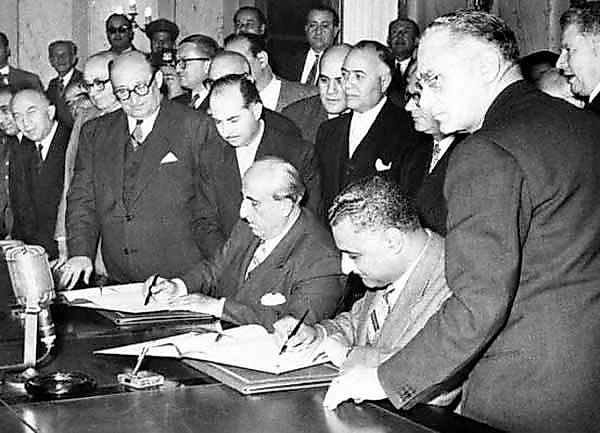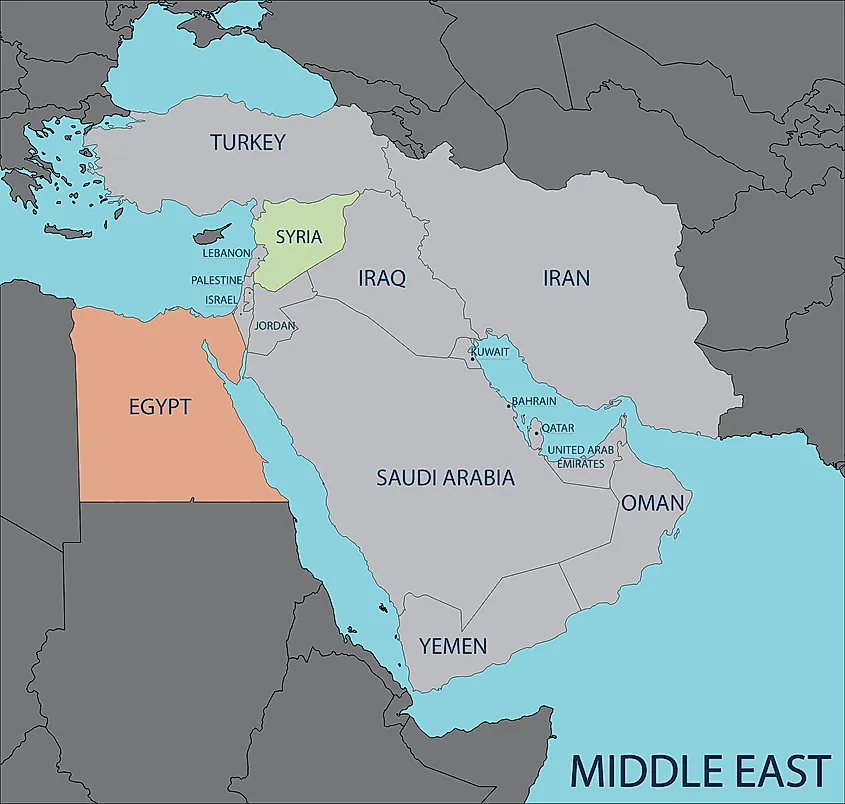
United Arab Republic
The United Arab Republic (UAR) was a short-lived union between the two Arab states of Egypt and Syria. The idea that the Arabs should be united into one nation arose following the end of World War I. It gained traction towards the end of World War II, and reached its peak of popularity in the 1950s and 1960s. The UAR was proclaimed in 1958, but lasted only three years, owing in large part to the marginalization of Syria by Egypt. This marginalization eventually led to Syria’s secession from the UAR, causing it to collapse.
The Rise Of Pan-Arabism
The origins of the UAR lie in the ideology of Pan-Arabism, which is the belief that all Arabs, regardless of which Arab state they live in, are part of one nation. During World War I, the Arabs were instrumental in fighting the forces of the Turkish Ottoman Empire. Much of the Arab world, specifically the Fertile Crescent region and the coastal region of the Arabian Peninsula bordering the Red Sea, was under Ottoman control, from which the Arabs sought liberation. In exchange for their help during the war, the Western powers promised the Arabs an independent state in the Arab territory that was to be liberated from the Ottoman Empire.
After the war, however, the Western powers reneged on their promise. Instead, the British and French divided the Arab territory of the former Ottoman Empire into separate colonial mandates. They also appointed rulers of their choosing to govern these new mandates, such as the Hashemite kings of Jordan and Iraq. These new rulers set about creating new national identities in their respective territories. Eventually, these colonial mandates would become independent countries. Nevertheless, the idea that all Arabs were part of one Arab nation continued to persevere.
One particular issue united the Arabs like no other: The intent of the British to turn Palestine into a national homeland for the Jewish people. This idea to turn what the Arabs believed was their land into a homeland for the Jews infuriated Arabs throughout the Arab world. In 1948, when the State of Israel declared independence, several Arab countries invaded the former British Mandate of Palestine in an attempt to destroy the nascent Jewish state. The Arab armies’ loss to Israel in the 1948 war would strengthen the idea of pan-Arabism even further.
Formation Of The United Arab Republic

The leaders responsible for the creation of the UAR were those of Egypt and Syria, which would become the two constituent states of the new union. In 1952, Gamal Abd Al-Nasser seized power in Egypt in a military coup. Four years later, he attempted to seize control of the Suez Canal, which was still under British protection. This act persuaded the armies of France, the UK, and Israel to invade Egypt. Nasser received support and admiration throughout the Arab world for his struggle against what Arabs saw as imperialist forces. This support made him the ideal candidate for leader of the soon-to-be formed UAR.
Meanwhile, in Syria, pan-Arabism was reflected in the party platforms of the country’s major political groupings, including the Muslim Brotherhood, the Communist Party, and the so-called Ba’th Party. It was the leaders of the Ba’th Party that first proposed the idea of a united Arab state with Egypt. When the Ba’thists proposed the unification of Egypt and Syria, however, Nasser was initially hesitant, worrying about the complications of uniting the two countries’ economic, civil, and military institutions, though he was eventually convinced to go along with the idea.

In February 1958, President Nasser of Egypt and President Shukri al-Quwatli of Syria signed a treaty of unification. Referendums were held in both countries to demonstrate popular support for the formation of the UAR. Afterwards, a constitution for the new union was drawn up. Cairo was made the capital of the UAR and Nasser was made its president. The UAR even adopted a flag. It looked exactly like the Egyptian flag, except that two stars were put in the middle, representing Egypt and Syria as the two constituent states of the union.
Support for the new UAR grew rapidly throughout the Arab world. So much so that other Arab states expressed their interest in joining it. Iraq, for example, expressed its intention to join the UAR following a coup that overthrew the country’s Western-backed monarchy in 1958. In the same year, the UAR established a loose federation with North Yemen, which was called the United Arab States, though this alliance did not result in North Yemen giving up any of its sovereignty, and was dissolved once the UAR collapsed.
Collapse Of The United Arab Republic
Despite the initial enthusiasm that greeted the formation of the UAR, problems with the union soon began to appear. Foremost among these problems was the balance of power between Egypt and Syria. Egypt was a much more powerful country, and Nasser used his country’s power advantage over Syria to dominate the politics of the new UAR. For example, he made sure that it was Egyptians rather than Syrians that held the highest government positions. He also dismissed several high ranking Syrians from certain positions.
Beginning in 1960, Nasser began attempts to harmonize the Syrian economy with that of Egypt. In 1961, he nationalized many of the economic sectors in the UAR without consulting Syrian officials. In addition, Nasser attempted to impose his own version of social justice. He restricted land ownership, imposed heavy taxes on people earning a certain amount of income, shortened the workday, and gave workers the right to representation on management boards and the right to a certain portion of company revenues.

Perhaps one of the most important moves that Nasser made, however, was to subordinate Syrian army officers to their Egyptian counterparts, which made the former extremely resentful. In fact, it was ultimately Syrian officers who brought an end to the UAR. On September 28, 1961, Syrian army officers staged a coup and declared Syria’s departure from the UAR. A short time later, the United Arab States, the UAR’s alliance with North Yemen, was dissolved. Attempts were made to salvage the union, but they did not bear fruit. Egypt retained the name “United Arab Republic” until 1971, while Syria still uses the UAR flag as its national flag to this day.











